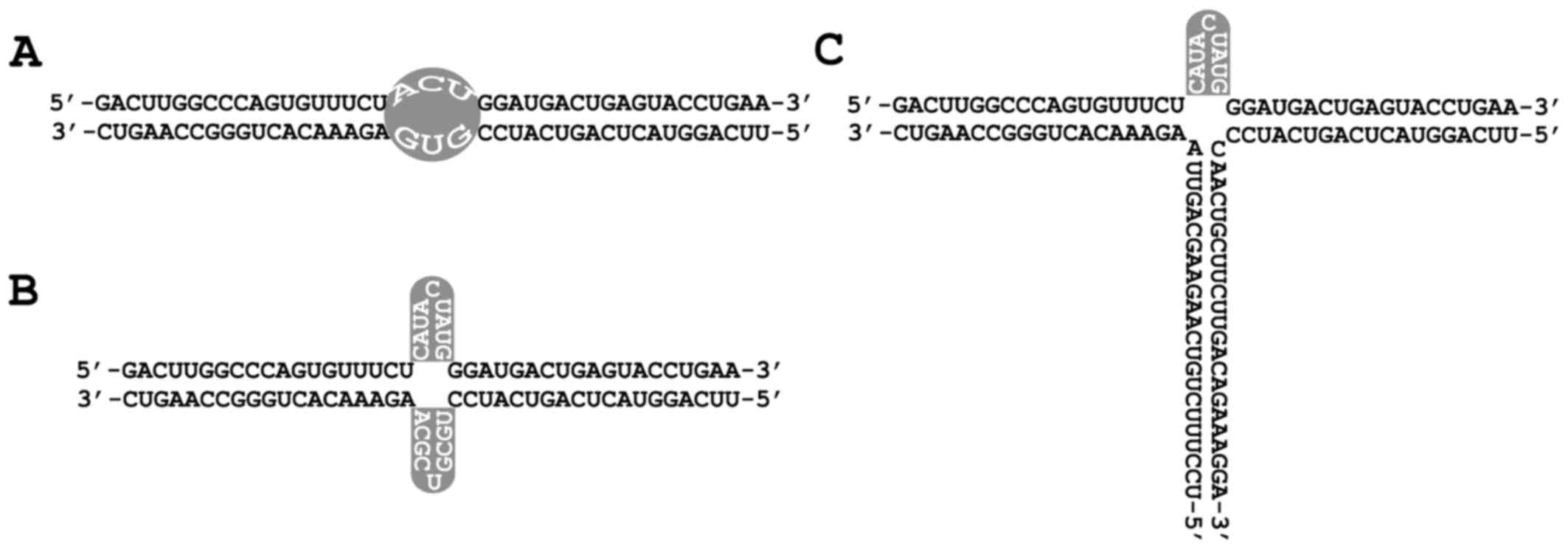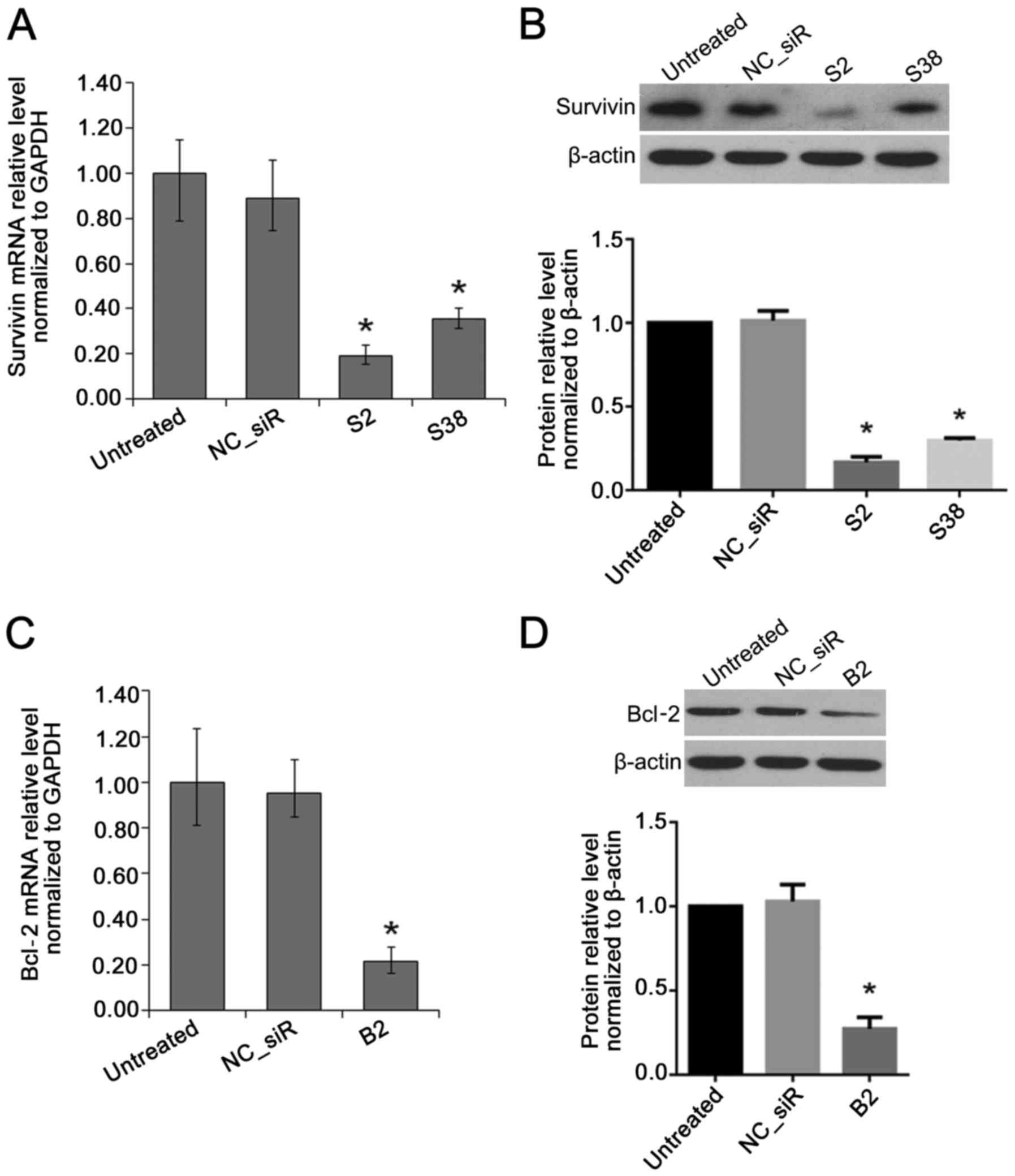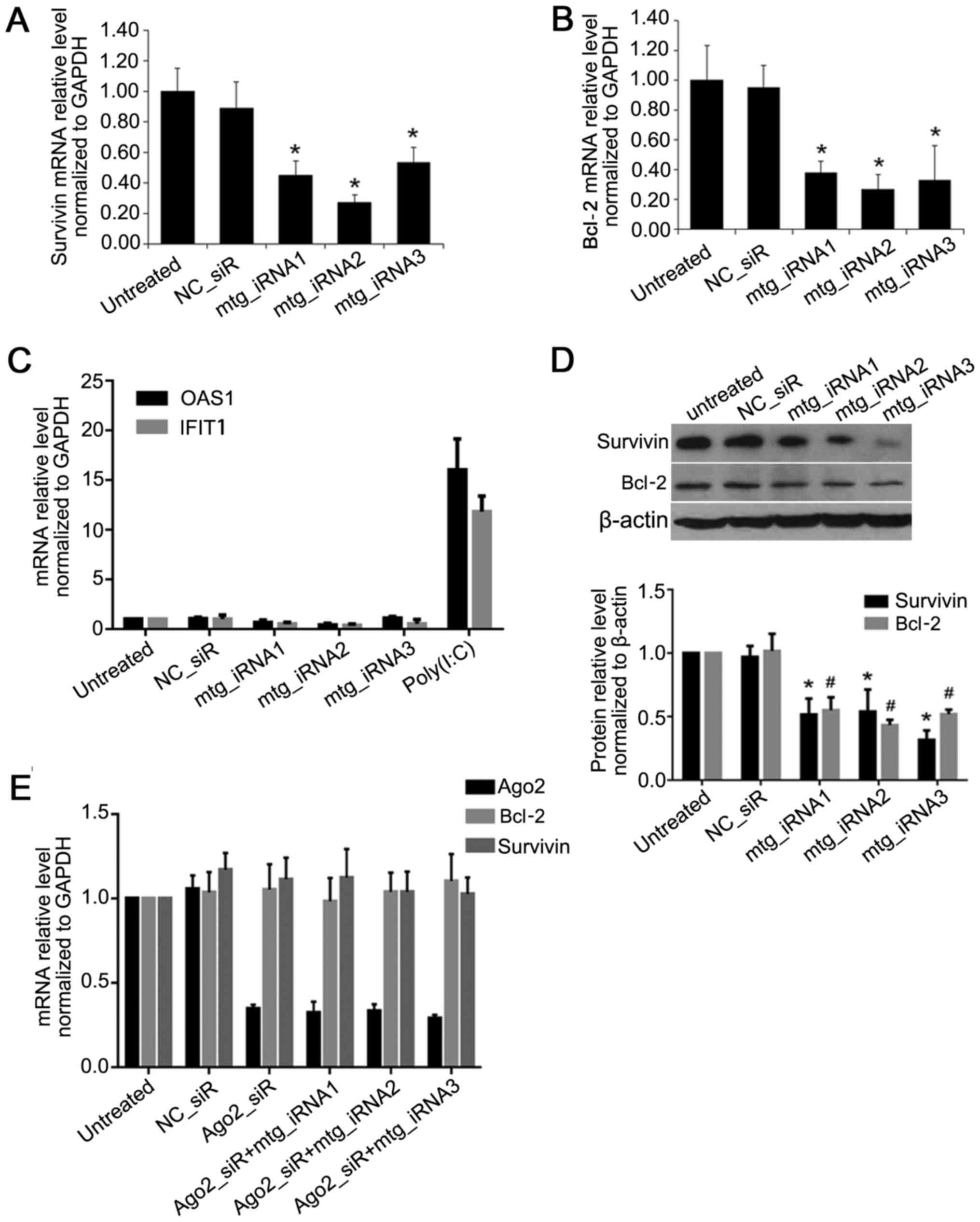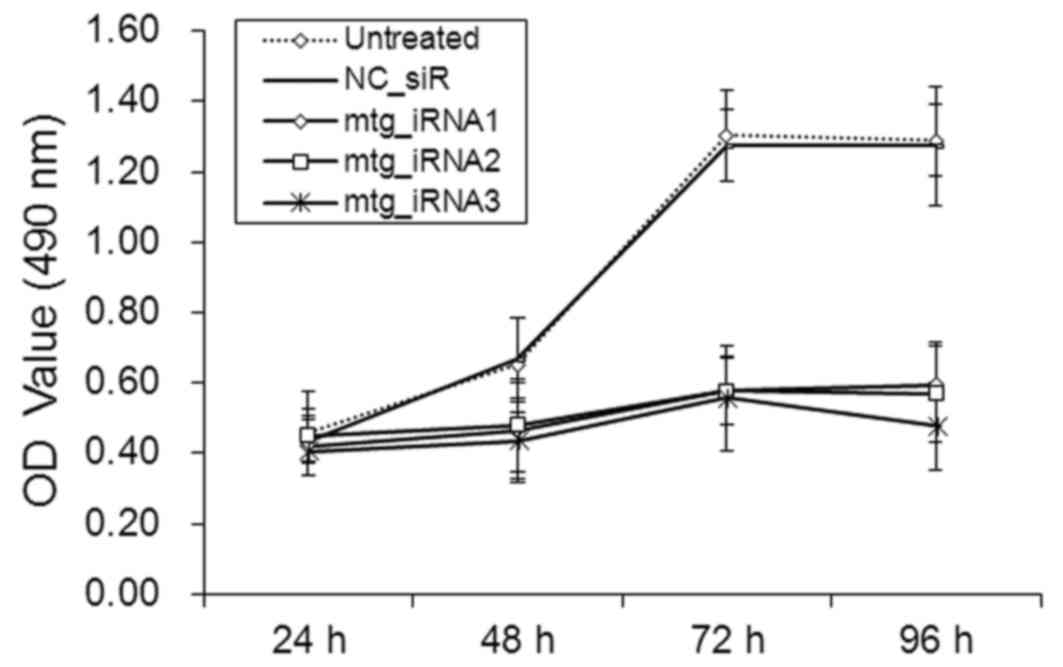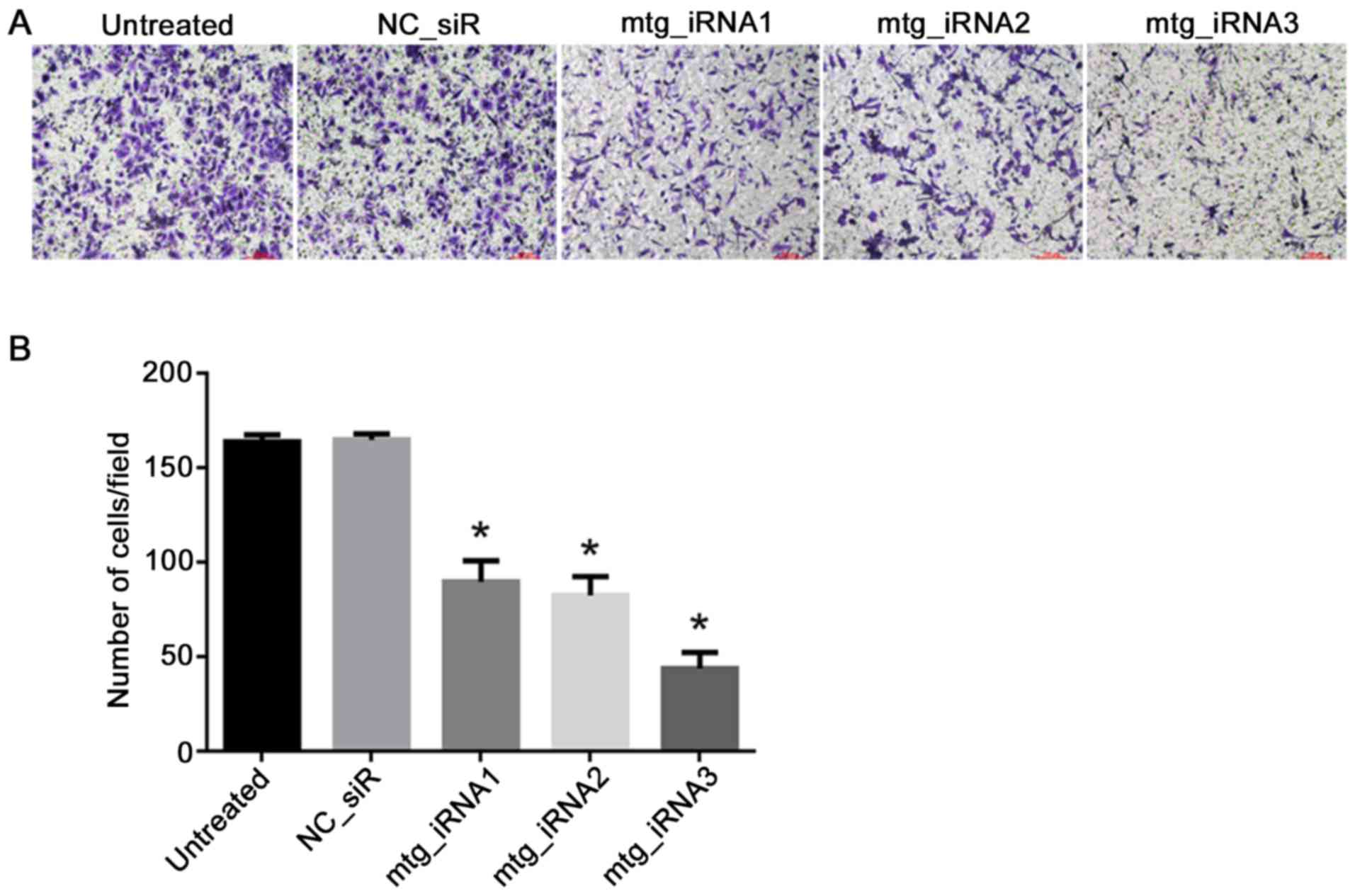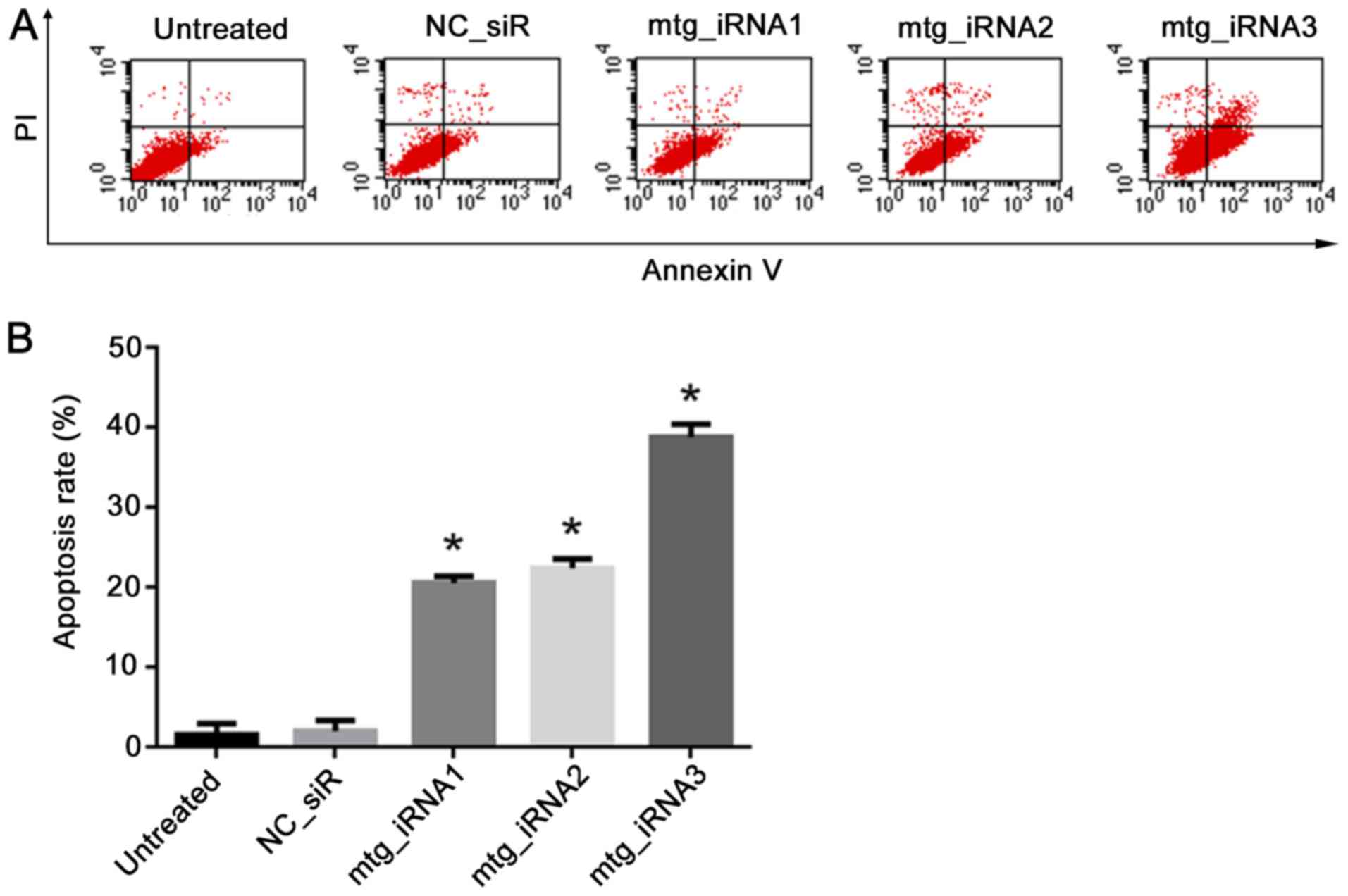Interfering RNA with multi-targets for efficient gene suppression in HCC cells
- Authors:
- Published online on: March 9, 2018 https://doi.org/10.3892/ijmm.2018.3557
- Pages: 3604-3610
Abstract
Introduction
RNA interference (RNAi) has shown tremendous potential in medicinal therapeutics development in past decade (1–4). Now, it has been confirmed that RNAi has great potential in treatment of various human diseases, such as viral infections (5,6), cancers (7–10) and orphan disease (11). Recently, an attempt using a long double-strand siRNA was made, as an alternative way, to carry on multiple interfering RNAs (iRNA) for multiple gene suppression for treatment of many human diseases (12–14), such as therapy for hepatocellular carcinoma (HCC) (10). Currently there are more than thirty types of siRNA drug candidates entered into the stage of clinical trials (15–17). However, these synthetic therapeutic long siRNA constructs in literature, including our previously study (18), were all based on a primary structure format (linearlized). It is a well-known fact that the longer the RNA molecule is, the easer the degradation occurs during RNA processing in circulation or in cell level.
To stabilize long therapeutic RNA, in the study we first described a group of long synthetic iRNA with multiple siRNA targets in secondary structures (loop or cloverleaf) and applied them to HCC cells for multiple gene suppression.
Materials and methods
Cell lines and cell culture
SMMC-7721 was cultured in Dulbecco's modified Eagle's medium (DMEM) supplemented with 10% fetal bovine serum (FBS), 2 mM L-glutamine, 100 U/ml of penicillin and 100 µg/ml of streptomycin (all from Thermo Fisher Scientific, Waltham, MA, USA). These cell lines were purchased from the Institute of Cell Biology, Chinese Academy of Sciences, and cells were maintained at 37°C with 5% CO2 and 95% air in a humidified incubator.
Multi-target iRNA format design and transfection
The gene sequence of survivin (accession no. NM_001168) and B-cell lymphoma-2 (Bcl-2) (accession no. NM_000633.2) were obtained from National Center of Biotechnology Information (NCBI) GenBank (USA), and the single target siRNA (19 bp duplex with 2-nt 3′-overhangs) targeting either survivin or Bcl-2 were screened in our precious studies (Table I) (18,19). A double-stranded RNA sequence with no homology with human genes was designed as siRNA negative control (NC_siR). All RNA oligonucleotides were synthesized by Biomics Biotechnologies Co., Ltd. (Nantong, China). The multi-target iRNA constructs targeting survivin and Bcl-2 were designed according to the principle of Biomics Biotechnologies Co., Ltd. (Table II). The cells were transfected in vitro with siRNAs using Lipofectamine® 2000 transfection reagent (Thermo Fisher Scientific) according to the instructions of the manufacturer.
Real-time quantitive PCR (RT-qPCR)
Total RNA of cells were extracted by RISO™ RNA extraction reagent (Biomics Biotechnologies Co., Ltd.) and then performed in a RT-qPCR reaction: 12.5 µl of 2X One-Step qPCR Mix (Biomics Biotechnologies Co., Ltd.), 0.5 µl of each forward and reverse primers (10 µM each; Biomics Biotechnologies Co., Ltd.), 0.5 µl of 50X SYBR-Green I and 4 µl total RNA was then subjected to reverse transcription for 30 min at 42°C and initially denatured at 95°C for 5 min, and then to 45 cycles of amplification with the condition of 95°C denaturation for 20 sec, 55°C annealing for 30 sec, and 72°C extension for 30 sec. Human glyceraldehyde 3-phosphate dehydrogenase (GAPDH) served as an internal control. The experiment was performed in triplicate. All primer sequences are shown in Table II. The results were analyzed by 2−ΔΔCt method (20).
Western blotting
Cells were plated in a 6-well plate at 1×106 cells/well and grown for 24 h until ~70–80% confluence. After cells were treated as described above for 48 h, they were harvested and lysed in RIPA buffer (Pierce, Rockford, IL, USA). Total protein was quantified by bicinchoninic acid (BCA) assay (Promega, Madison, WI, USA), and then ~20 µg of protein was separated by polyacrylamide gel electrophoresis (PAGE) and electroblotted onto polyvinylidine difluoride filter (PVDF) membranes (Millipore, Billerica, MA, USA), followed by blocking with 5% skim milk in TBST (20 mM Tris, 150 mM NaCl, 0.05% Tween-20, pH 7.5) buffer for 2 h at room temperature, then incubated with rabbit anti-human survivin antibody (1:500 dilution) and mouse anti-human Bcl-2 (1:500 dilution), mouse anti-human β-actin antibody (1:500 dilution) (all from Abcam, Cambridge, MA, USA) as internal control. The membranes were washed in TBST and incubated with a goat anti-rabbit or goat anti-mouse HRP-conjugated secondary antibody (1:1,000 dilution; Jackson Immunoresearch, West Grove, PA, USA) at room temperature for 2 h. Then, the specific proteins were detected with ECL chemiluminescence reagent (Beyotime, Beijing, China); the membranes were exposed to film (Kodak, Rochester, NY, USA).
Cell viability assay
MTT assay was used to measure the viability of cells. Cells were plated into a 96-well plate at 5×103 cells/well and grown for 24 h, then treated as above for 0, 24, 48, 72 and 96 h, 10 µl MTT (Beyotime) were added to each well of 96-well plate containing 100 µl DMEM medium and incubated at 37°C for 4 h, then 150 µl/well DMSO was added and incubation was continue at 37°C for 10 min. The optical density (OD) was measured at 490 nm using a Microplate Reader (Bio-Rad, Hercules, CA, USA).
Cell invasion assay
Cells were seeded into a 24-well plate at 2×104 cells/well and grown for 24 h, then treated as described above, post 48 h treament, cells were suspended in DMEM medium at the density of 1×106 cells/ml. Briefly, Transwell chambers (Corning, Inc., Corning, NY, USA) and treated with DMEM for 1 h before treatments; an 8 µm pore polycarbonate membrane was coated with 50 µl of 0.5 mg/ml Matrigel (BD Biosciences, San Jose, CA, USA) and used to separate the upper and lower chambers. Cell suspension (100 µl) was added into each upper chamber and 600 µl DMEM containing 10% FBS or conditioned medium which was the cell supernatant with siRNAs post-transfected for 48 h. The cells on the top surface of the membrane were carefully removed at 24 h post treatments. Cells on the Transwell chambers were fixed for 30 sec in 10% formaldehyde, and then stained by 0.5% crystal violet, after washing by phosphate-buffered saline (PBS), the cells on the top surface of the membrane were carefully removed again. The cells on the bottom surface of the membrane were counted in 3–5 random fields under a microscope (magnification, ×100).
Cell apoptosis assay
Annexin V-FITC/PI double staining and flow cytometry (FCM) analysis method was used to determine cell apoptosis. Briefly, 1×106 cells/well in a 6-well plate treated with different treatments as above for 48 h were harvested and washed in PBS, cells were stained by using Annexin V-FITC apoptosis detection kit (Sigma-Aldrich, St. Louis, MO, USA), then detected by FCM analysis (BD Biosciences).
Statistical analysis
All experiments were performed independently three times, the results are shown as mean ± standard deviation (SD), and statistical analyses were performed using SPSS 19.0 software. The differences were compared using Student's t-test and one way ANOVA followed by post hoc test to assess statistical significance. All P-values were based on a two-sided statistical analysis and P<0.05 was considered to indicate statistical significance.
Results
Designing different multi-target iRNAs
Multi-target iRNAs targeting survivin and Bcl-2 were designed according to different structure formats (Fig. 1). The sense and antisense strands of iRNAs were synthesized by Biomics Biotechnologies Co., Ltd. and iRNAs were obtained after annealing of both strands (Table II and Fig. 1).
Inhibition effects of target genes in HCC cells by multi-target iRNAs
The result of RT-qPCR and western blot analysis showed that, compared with untreated cell, the mRNA and protein level of survivin were both inhibited by survivin siRNA (S2 or S38). The mRNA and protein level of Bcl-2 were both inhibited by Bcl-2 siRNA (B2) (P<0.05) (Fig. 2).
Compared to untreated group, the mRNA level of survivin was inhibited by multi-target interfering RNAs (mtg_iRNA1), mtg_iRNA2 and mtg_iRNA3 up to 45, 27 and 53% (P<0.05) (Fig. 3A); the mRNA level of Bcl-2 was inhibited up to 38, 27 and 33% (P<0.05) (Fig. 3B); and there was no difference between NC_siRNA and untreated ones. Moreover, mtg_iRNA1, mtg_iRNA2 and mtg_iRNA3 showed no interferon response (Fig. 3C). The protein level of survivin was inhibited by mtg_iRNA1, mtg_iRNA2 and mtg_iRNA3 up to 48, 46 and 68%, respectively (P<0.05); the protein level of Bcl-2 was inhibited up to 45, 57 and 48% (P<0.05), and there was no difference between NC_siR and untreated group (P>0.05) (Fig. 3D).
Gene knockdown by mtg_iRNAs in an Ago2-dependent manner
Long double-stranded RNA was reported with gene knockdown effect in an Ago2-dependent manner (21). To verify the manner of the effect of mtg_iRNAs, the Ago2 siRNA (sense, 5′-AAUCUCUUCUUGCCGAUCGdTdT-3′ and antisense, 5′-CGAUCGGCAAGAAGAGAUUdTdT-3′) was used to knockdown the expression of Ago2, and we further investigated whether mtg_iRNAs could downregulate the target genes. As shown in Fig. 3, compared with untreated cells, the expression of Ago2 was inhibited efficiently by Ago2_siR, when Ago2 was downregulated, target gene survivin or Bcl-2 could not be inhibited by mtg_iRNAs, and thus gene knockdown by mtg_iRNAs was Ago2-dependent (Fig. 3E).
Inhibition effects on cell viability by multi-target siRNAs
The viability of SMMC-7721 cells was measured by MTT assay. The absorbance values (490 nm) of the cells at 48, 72 and 96 h post-transfection with mtg_iRNA1, mtg_iRNA2 and mtg_iRNA3 were significantly lower than those of NC_siR treated and untreated cells, respectively (P<0.05) (Fig. 4). There was no significant difference between NC_siR treated and untreated cells (P>0.05).
Inhibition effects on cell invasion by multi-target siRNAs
The cell invasion abilities with different treatments were detected by Transwell assay, the result showed that the invasion of the cells treated with mtg_iRNA1, mtg_iRNA2 and mtg_iRNA3 were inhibited significantly post 48 h transfection (P<0.05). There was no significant difference of inhibition abilities between NC_siR and untreated cells (P>0.05) (Fig. 5).
Cell apoptosis induces multi-target siRNAs
Annexin V-FITC/PI double staining and FCM analysis were used to detect the ability of mtg_iRNAs on inducing SMMC-7721 cell apoptosis. The result showed that cells treated with mtg_iRNA1, 20.52±0.81%, mtg_iRNA2, 22.36±1.15% and mtg_iRNA3, 38.79±1.63% resulted in a significant increase of apoptosis compared with that of NC_siR treated cells, 1.96±1.35% and untreated cells, 1.52±1.41% (P<0.05) (Fig. 6).
Discussion
The present study is the first attempt to use long synthetic iRNA formats (loop or cloverleaf) to carry multiple siRNA targets. Survivin and Bcl-2 were used as HCC therapeutic targets in our study for iRNA therapeutics development. survivin is an apoptosis inhibitor that is expressed during the G2/M phase of the cell cycle and it is a member of the inhibitor of apoptosis (IAP) gene family, survivin encodes negative regulatory proteins that prevent apoptotic cell death (25). Bcl-2 is specifically considered as an important anti-apoptotic oncogene, and it is the founding member of the Bcl-2 family of regulator proteins that regulate cell death (26,27).
The efficiency of gene co-inhibition by long secondary structure iRNA was demonstrated (Fig. 3A, B and D), in which all three mtg_iRNAs inhibited target genes (survivin or Bcl-2) effectively in both mRNA and protein level.
The side-effect of undesired interferon response caused long double-stranded RNA (dsRNA) is a major concern. It was addressed by a previous study indicating that specific gene knockdown via RNAi triggered by long dsRNA could induce interferon response (28), thus the expression of OAS1 and IFIT1 were detected to monitor the interferon response and a synthetic dsRNA analog-poly(I:C) was used as positive control (29). The designed long secondary structure iRNAs here had no obvious interferon response in mammalian cells (Fig. 3C). RNAi effects can be triggered by different structural modifications of siRNA, also long multi-target based siRNA structures designed as Dicer substrates have been developed in therapeutic research (19), and these siRNAs were all Ago2-dependent. In the present study, also our mtg_iRNAs were all Ago2-dependent by the method of Ago2 downregulation first (Fig. 3E). Furthermore, we demonstrated that the proliferation and invasion of HCC cells were inhibited, also cell apoptosis was promoted by mtg_iRNAs effectively (Fig. 4Figure 5–6). The results of this study demonstrated that the designed mtg_iRNAs construct had RNAi activities on knockdown target genes simultaneously. The results showed that, mtg_iRNAs may be a preferred strategy for multigenic disease therapy, especially in cancer.
In conclusion, the long iRNA with different formats (loop and cloverleaf) showed initial multi-gene co-inhibition effects without showing side-effect of interferon response. The design could be as an alternative way to open its new applications in RNAi based gene therapy and drug development.
Acknowledgments
Not applicable.
Notes
[1] Funding
This study was supported by the National High Technology Research and Development Program of China (863 Program, no. 2012AA022501); the National Science and Technology Major Project of China (no. 2013ZX09301303-005).
[2] Availability of data and material
The datasets used and/or analyzed during the current study are available from the corresponding author on reasonable request.
[3] Authors' contributions
TL and YYZ designed the study. YYZ designed the different structures of multi-target interfering RNAs. TL, YJ and SZ performed the RT-qPCR, western blot analysis, MTT. TL performed the cell invasion assay and cell apoptosis assay. TL was a major contributor in writing the manuscript; YYZ revised the manuscript and supervised the study. All authors read and approved the final manuscript.
[4] Ethics approval and consent to participate
Not applicable.
[5] Consent for publication
Not applicable.
[6] Competing interests
The authors declare that they have no competing interests.
References
|
Fire A, Xu S, Montgomery MK, Kostas SA, Driver SE and Mello CC: Potent and specific genetic interference by double-stranded RNA in Caenorhabditis elegans. Nature. 391:806–811. 1998. View Article : Google Scholar : PubMed/NCBI | |
|
Chendrimada TP, Gregory RI, Kumaraswamy E, Norman J, Cooch N, Nishikura K and Shiekhattar R: TRBP recruits the Dicer complex to Ago2 for microRNA processing and gene silencing. Nature. 436:740–744. 2005. View Article : Google Scholar : PubMed/NCBI | |
|
Hammond SM, Bernstein E, Beach D and Hannon GJ: An RNA-directed nuclease mediates post-transcriptional gene silencing in Drosophila cells. Nature. 404:293–296. 2000. View Article : Google Scholar : PubMed/NCBI | |
|
Elbashir SM, Lendeckel W and Tuschl T: RNA interference is mediated by 21- and 22-nucleotide RNAs. Genes Dev. 15:188–200. 2001. View Article : Google Scholar : PubMed/NCBI | |
|
Chen J, Shi X, Zhang X, Wang L, Luo J, Xing G, Deng R, Yang H, Li J, Wang A, et al: Porcine reproductive and respiratory syndrome virus (PRRSV) inhibits RNA-mediated gene silencing by targeting Ago-2. Viruses. 7:5539–5552. 2015. View Article : Google Scholar : PubMed/NCBI | |
|
Nikitenko NA, Speiseder T, Lam E, Rubtsov PM, Tonaeva KhD, Borzenok SA, Dobner T and Prassolov VS: Regulation of human adenovirus replication by RNA interference. Acta Naturae. 7:100–107. 2015.PubMed/NCBI | |
|
Tai W, Qin B and Cheng K: Inhibition of breast cancer cell growth and invasiveness by dual silencing of HER-2 and VEGF. Mol Pharm. 7:543–556. 2010. View Article : Google Scholar : PubMed/NCBI | |
|
Shahzad MM, Lu C, Lee JW, Stone RL, Mitra R, Mangala LS, Lu Y, Baggerly KA, Danes CG, Nick AM, et al: Dual targeting of EphA2 and FAK in ovarian carcinoma. Cancer Biol Ther. 8:1027–1034. 2009. View Article : Google Scholar : PubMed/NCBI | |
|
Kim DH, Behlke MA, Rose SD, Chang MS, Choi S and Rossi JJ: Synthetic dsRNA Dicer substrates enhance RNAi potency and efficacy. Nat Biotechnol. 23:222–226. 2005. View Article : Google Scholar | |
|
Tabernero J, Shapiro GI, LoRusso PM, Cervantes A, Schwartz GK, Weiss GJ, Paz-Ares L, Cho DC, Infante JR, Alsina M, et al: First-in-humans trial of an RNA interference therapeutic targeting VEGF and KSP in cancer patients with liver involvement. Cancer Discov. 3:406–417. 2013. View Article : Google Scholar : PubMed/NCBI | |
|
Coelho T, Adams D, Silva A, Lozeron P, Hawkins PN, Mant T, Perez J, Chiesa J, Warrington S, Tranter E, et al: Safety and efficacy of RNAi therapy for transthyretin amyloidosis. N Engl J Med. 369:819–829. 2013. View Article : Google Scholar : PubMed/NCBI | |
|
Zimmermann GR, Lehár J and Keith CT: Multi-target therapeutics: When the whole is greater than the sum of the parts. Drug Discov Today. 12:34–42. 2007. View Article : Google Scholar : PubMed/NCBI | |
|
Li T, Wu M, Zhu YY, Chen J and Chen L: Development of RNA interference-based therapeutics and application of multi-target small interfering RNAs. Nucleic Acid Ther. 24:302–312. 2014. View Article : Google Scholar : PubMed/NCBI | |
|
Boyapalle S, Xu W, Raulji P, Mohapatra S and Mohapatra SS: A multiple siRNA-based anti-HIV/SHIV microbicide shows protection in both in vitro and in vivo models. PLoS One. 10:e01352882015. View Article : Google Scholar : PubMed/NCBI | |
|
Takeshita F and Ochiya T: Therapeutic potential of RNA interference against cancer. Cancer Sci. 97:689–696. 2006. View Article : Google Scholar : PubMed/NCBI | |
|
Aigner A: Applications of RNA interference: Current state and prospects for siRNA-based strategies in vivo. Appl Microbiol Biotechnol. 76:9–21. 2007. View Article : Google Scholar : PubMed/NCBI | |
|
Davidson BL and McCray PB Jr: Current prospects for RNA interference-based therapies. Nat Rev Genet. 12:329–340. 2011. View Article : Google Scholar : PubMed/NCBI | |
|
Peng W, Chen J, Qin Y, Yang Z and Zhu YY: Long double-stranded multiplex siRNAs for dual genes silencing. Nucleic Acid Ther. 23:281–288. 2013. View Article : Google Scholar : PubMed/NCBI | |
|
Li T, Zhu YY, Chen L, Sun Y, Yuan J, Graham M and French P: Size unbiased representative enzymatically generated RNAi (SURER) library and application for RNAi therapeutic screens. Nucleic Acid Ther. 25:35–46. 2015. View Article : Google Scholar : | |
|
Livak KJ and Schmittgen TD: Analysis of relative gene expression data using real-time quantitative PCR and the 2(−Delta Delta C(T)) method. Methods. 25:402–408. 2001. View Article : Google Scholar | |
|
Chang CI, Kang HS, Ban C, Kim S and Lee DK: Dual-target gene silencing by using long, synthetic siRNA duplexes without triggering antiviral responses. Mol Cells. 27:689–695. 2009. View Article : Google Scholar : PubMed/NCBI | |
|
Rice RR, Muirhead AN, Harrison BT, Kassianos AJ, Sedlak PL, Maugeri NJ, Goss PJ, Davey JR, James DE and Graham MW: Simple, robust strategies for generating DNA-directed RNA interference constructs. Methods Enzymol. 392:405–419. 2005. View Article : Google Scholar : PubMed/NCBI | |
|
Shin D, Lee H, Kim SI, Yoon Y and Kim M: Optimization of linear double-stranded RNA for the production of multiple siRNAs targeting hepatitis C virus. RNA. 15:898–910. 2009. View Article : Google Scholar : PubMed/NCBI | |
|
Aviñó A and Ocampo SM: Perales and JC Eritja R: Branched RNA: A new architecture for RNA interference. J Nucleic Acids. 5869352011. | |
|
Verdecia MA, Huang H, Dutil E, Kaiser DA, Hunter T and Noel JP: Structure of the human anti-apoptotic protein survivin reveals a dimeric arrangement. Nat Struct Biol. 7:602–608. 2000. View Article : Google Scholar : PubMed/NCBI | |
|
Tsujimoto Y, Finger LR, Yunis J, Nowell PC and Croce CM: Cloning of the chromosome breakpoint of neoplastic B cells with the t(14;18) chromosome translocation. Science. 226:1097–1099. 1984. View Article : Google Scholar : PubMed/NCBI | |
|
Cleary ML, Smith SD and Sklar J: Cloning and structural analysis of cDNAs for bcl-2 and a hybrid bcl-2/immunoglobulin transcript resulting from the t(14;18) translocation. Cell. 47:19–28. 1986. View Article : Google Scholar : PubMed/NCBI | |
|
Elbashir SM, Harborth J, Lendeckel W, Yalcin A, Weber K and Tuschl T: Duplexes of 21-nucleotide RNAs mediate RNA interference in cultured mammalian cells. Nature. 411:494–498. 2001. View Article : Google Scholar : PubMed/NCBI | |
|
Palchetti S, Starace D, De Cesaris P, Filippini A, Ziparo E and Riccioli A: Transfected poly(I:C) activates different dsRNA receptors, leading to apoptosis or immunoadjuvant response in androgen-independent prostate cancer cells. J Biol Chem. 290:5470–5483. 2015. View Article : Google Scholar : PubMed/NCBI |



